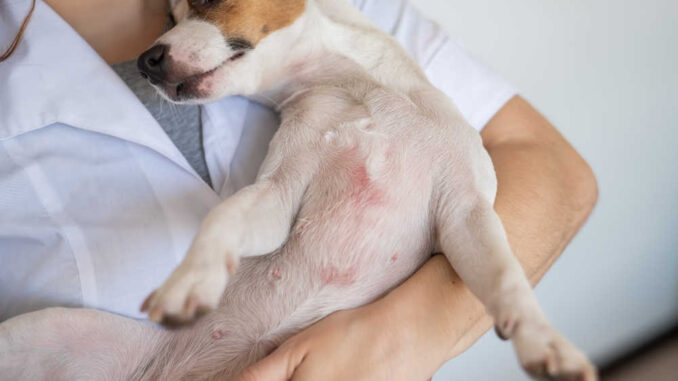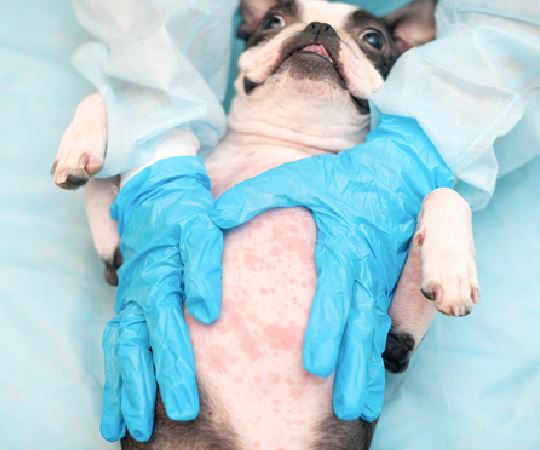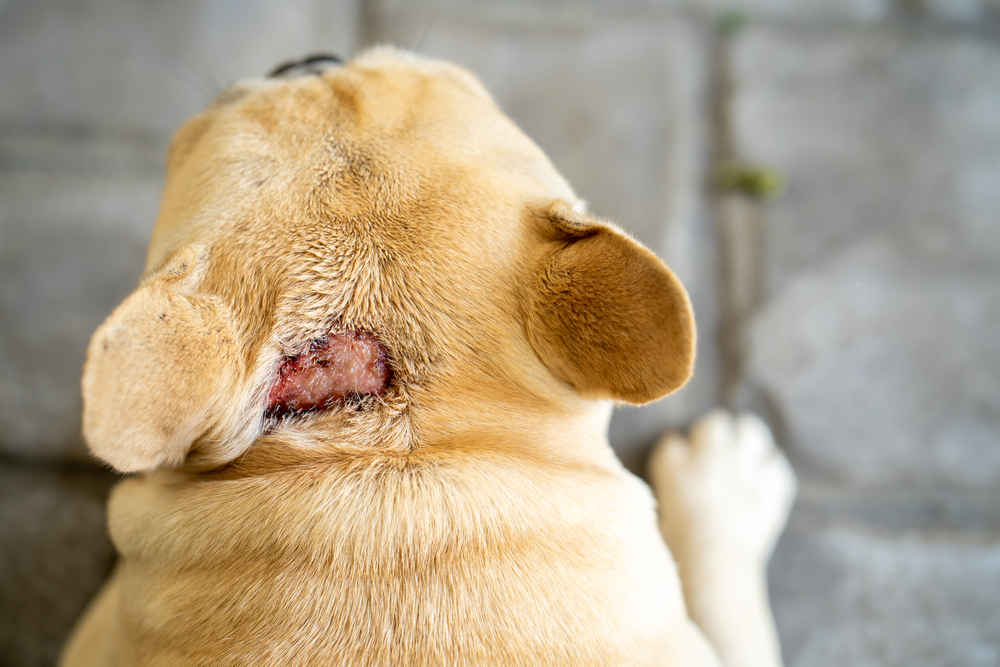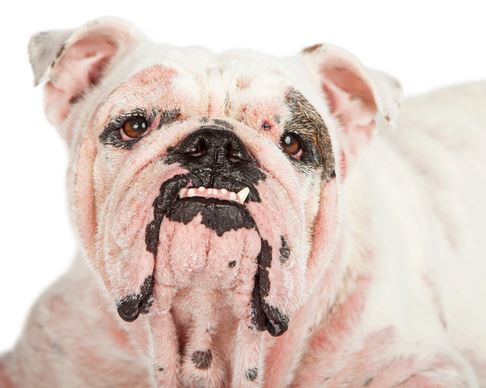
This article was updated on June 18th, 2023
Does your dog have an itch they just can’t seem to scratch? Itchy red skin and rashes are common issues and can leave you and your dog desperate for relief. So what’s causing that persistent itch or red rash – and what can you do about it at home?
A rash is any area of irritated, inflamed or swollen skin and they’re often very itchy. Many dogs have occasional itches – and the treatments below can certainly help with this – but if you notice a rash or your dog is persistently scratching, it’s important to see your vet sooner rather than later. Rashes and itching can be due to infections, parasites and allergies which can all get a lot worse without effective treatment.
It’s tempting to try home remedies for a little relief but most are at best unlikely to be effective and at worst may cause further irritation or make it harder for your vet to diagnose what’s going on. Read on for details of what you CAN try at home – and what might cause more harm than good.
Different rashes and how to treat them at home
Many different conditions can affect the skin, including bacterial and fungal infections, parasites like fleas and mites, dietary and environmental allergies and rarer conditions like autoimmune disorders. Below, we’ll summarise the most common causes and what you can do to help – but any rash that persists for longer than a few days or causes significant irritation should be checked out by a vet.
1. Allergies
One of the most common causes of itchy red skin is allergic skin disease, also known as atopy. This can be a response to either dietary allergens (usually proteins e.g. chicken or fish), or environmental allergens (e.g. pollen, dust mites). This usually starts in young dogs young and often causes itchy red feet, ears and sometimes bellies.

There are many veterinary treatments available, so it’s worth discussing this with your vet if you think your dog might be affected. In the meantime, it’s definitely worth trying some of the home treatments below – dogs with allergies have damaged skin barriers, so oatmeal baths1 and omega 3 supplements can help to soothe the skin. A hypoallergenic diet trial is also worth trying to rule out dietary allergies. Finally, I always recommend owners rinse their dog’s paws in water after a walk – removing the pollen before it can cause itching can really help!
1. Oatmeal bathing
- Mix colloidal oatmeal (or finely ground plain oats) with warm water
- Either apply directly to the skin or allow your dog to soak for 10-15 minutes
- Gently but thoroughly pat dry
- Repeated daily or as needed
- DOG SKIN VS. HUMAN SKIN - Dogs' skin has a higher pH, so human shampoos can be harmful. This dog shampoo keeps their coat healthy and without irritation, making it an essential part of your dog bathing supplies
2. Omega 3 supplements
Omega 3 supplementation in the form of fish oil or flax oil has been shown to reduce signs of allergic skin disease2. It’s worth adding these into your dog’s diet – but giving too much can be harmful, so you should always check you’re dosing appropriately. There are many supplements now available for dogs which contain a safe amount of Omega 3.
- Great Tasting Omega 3 for Dogs - Fish oil for dogs skin and coat ; Itch relief for dogs with no fishy smell, no mess ; Small easy to chew omega 3 fish oil for dogs ; Bite-sized bacon and beef liver flavored skin and coat supplement for dogs
3. Hypoallergenic diet trial
It’s worth trying a hypoallergenic diet to rule out your food allergies. Surprisingly, many dogs with food allergies don’t have any gastrointestinal signs – instead, they’re often itchy. To see if diet could be causing your dog’s itching you’ll need to do the following:
- Pick a hypoallergenic diet (with your veterinarian) – some diets use this label but still contain a high number of allergens. We recommend picking a scientifically formulated diet such as Royal Canin Hypoallergenic, Purina Hypoallergenic or Hill’s z/d (unsponsored).
- Transition to the new food over several days to avoid stomach upsets
- Give your dog only the hypoallergenic food for 6-8 weeks. It takes a long time for the skin to recover – if your dog sneaks any treats or normal food, this can inflame the skin and mean you have to start from scratch!
- If your dog’s skin has improved, try reintroducing their normal food. If the skin flares up shortly after you reintroduce the normal food, you know your dog is likely to have a dietary allergy.
2. Infections
Infections are a very common cause of skin rashes and itching. Bacterial infections commonly cause patchy red rashes which have an irregular, bumpy surface. They can also cause more focal ‘hot spots’ which develop rapidly in a small area causing significant discomfort and often producing pus and discharge.

These can progress rapidly so early veterinary treatment is key – but there are still things you can do at home to help:
1. Saltwater bathing
For any irritated skin, especially if discharge or pus is present
- Boil water and let it cool, then add approximately half a teaspoon of salt to a mug of water
- Use this to gently bathe the area, 1-2x daily or more often if there is discharge
If there is an open, ulcerated or wounded area, we recommend seeing your vet as soon as possible
2. Chlorhexidine (disinfectant) scrubs and wipes
Chlorhexidine is a powerful antiseptic agent used by vets to clean skin rashes and wounds. It should always be diluted (at least 4 parts water to 1 part Hibiscrub) and is usually used once daily.
Important – chlorhexidine is usually not enough to treat skin infections alone. It can also dry the skin out and potentially worsen itching caused by other conditions. Using chlorhexidine repeatedly on wounds can delay healing so is usually not recommended. The safest and easiest way to use chlorhexidine at home is to use chlorhexidine wipes (e.g. CLX wipes) once daily to keep the area clean.
- Non Stinging Cleaning Wipes with Topical Solution for the Topical Management of Skin and Coat.
If your dog is prone to infections in their skin folds (common in breeds like French Bulldogs, Bassett Hounds and Shar Peis) these wipes should be used daily.
3. Creams and ointments
Sudocrem – creams like Sudocrem contain zinc oxide, which can be toxic if ingested in significant quantities. It’s also very difficult to remove from the skin for your vet to assess the rash or apply medications. If you use this it should be in very small quantities and you should prevent your pet licking it.
Antiseptic creams e.g. Savlon, Germolene – these can be used on small scrapes or irritated areas of skin to help prevent infection and soothe the area. Again, these shouldn’t be ingested in large amounts and are unlikely to resolve an infection.
Aloe vera – many people recommend aloe vera for sensitive skin. While it may help some dogs, it’s important to note that it can worsen irritation in others. If your dog eats large amounts it may also be toxic.
It’s generally best to avoid applying creams or ointments without consulting with your vet. Applying many products can make it harder for your vet to assess, affect diagnostic tests (e.g. skin scrapes) and may even worsen irritation. In addition, some human products can cause toxicity. If the area if particularly sore, bathing it with oatmeal (as described above for allergies) is a safe way to soothe irritated skin.
3. Parasites

Parasites are another common cause of skin rashes and irritation, although the likelihood of this is significantly reduced if your dog is up to date with an effective anti-parasite treatment. The main type of parasites we see are fleas and mites, which cause various types of mange. Many flea treatments now also prevent mites, but it’s worth checking whether your regular products do as many over the counter products are ineffective against mites.
Fleas can usually be identified by black specks of ‘flea dirt’ (faeces containing dried blood) scattered throughout your dog’s coat. Mites are more likely to cause a localised itchy rash to develop.
If your pet is generally itchy and is not up to date on parasite prevention, it may be worth trying this before seeking veterinary attention. If your dog has mites, however, these can be difficult to treat and cause a lot of irritation. If your dog’s itching does not start to improve within a week of applying a treatment, or your dog has a visible rash, it’s worth checking they don’t need any further investigations or treatments with your vet.
Related post: Red Skin and Rashes in Dogs: Pictures & Vet Advice
Is there anything else I can do?
For any itchy rash, you should consider the use of a buster collar to prevent your dog licking. While it may be unpleasant – and certainly isn’t a long-term solution – your dog licking and chewing at irritated areas can make them a lot worse and cause secondary infections to develop. While you’re waiting to see a vet, it may be worth popping a collar on while using some of the tips above to try to soothe their irritated skin.
How serious is a rash – and when should I see a vet?
Most rashes are not a serious medical concern but can still significantly affect your dog’s quality of life. Uncontrolled itching can make both your dog (and you) desperate for relief. If home remedies aren’t helping after a few days, it’s worth seeing your vet as there are many veterinary treatments available for the conditions above.
Some rashes are more serious than others, however. If you notice your dog has a red rash that is very sore or has discharge, or has a rash that is expanding rapidly, let your vet know and they can schedule you a more urgent appointment. Rashes caused by infections or mites can spread very rapidly and become harder to treat (and more unpleasant for your dog!) so early diagnosis is best.
If your dog is showing any other symptoms like lethargy, reduced appetite, a change in thirst, vomiting or diarrhoea, he should be seen more urgently. Occasionally rashes can indicate more serious disease like an autoimmune condition.
Related post: Red Skin and Rashes in Dogs: Pictures & Vet Advice
Sources
1 – Reynertson, K. A., Garay, M., Nebus, J., Chon, S., Kaur, S., Mahmood, K., Kizoulis, M., & Southall, M. D. (2015). Anti-inflammatory activities of colloidal oatmeal (Avena sativa) contribute to the effectiveness of oats in treatment of itch associated with dry, irritated skin. Journal of drugs in dermatology : JDD, 14(1), 43–48.
2 – Mueller, R. S., Fieseler, K. V., Fettman, M. J., Zabel, S., Rosychuk, R. A., Ogilvie, G. K., & Greenwalt, T. L. (2004). Effect of omega-3 fatty acids on canine atopic dermatitis. The Journal of small animal practice, 45(6), 293–297.
Disclaimer: This website's content is not a substitute for veterinary care. Always consult with your veterinarian for healthcare decisions. Read More.





Be the first to comment